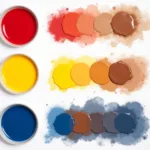Blue, a color often associated with tranquility and depth, plays a significant role in our visual world. But what happens when we seek its contrasting counterpart? Understanding color relationships, especially opposites or complements, is crucial for effective design, art, and even everyday style choices. This article delves into the fascinating world of color theory to uncover the true opposite of blue.
Decoding the Color Wheel: Finding Blue’s Complement
The concept of opposite colors hinges on the color wheel, a visual representation of colors arranged according to their relationships. The most common color wheel is based on the RYB (Red, Yellow, Blue) primary color model, although artists and designers often use the more scientifically accurate RGB (Red, Green, Blue) or CMYK (Cyan, Magenta, Yellow, Key/Black) models. On the RYB color wheel, the opposite of a color, also known as its complementary color, sits directly across from it. So, what is opposite of blue on the color wheel? It’s orange.
Why Orange is the Opposite of Blue
The complementary relationship between blue and orange creates a dynamic visual contrast. When placed next to each other, they intensify each other’s vibrancy, creating a striking effect. This is due to how our eyes perceive color. After staring at a color for a while, our eyes naturally seek its complement. This phenomenon makes complementary color pairings particularly eye-catching. Similar to what color is the opposite of blue, understanding this contrast is key to creating balanced and visually appealing compositions.
Exploring Shades and Hues: Beyond Basic Blue and Orange
While we’ve established that orange is the opposite of blue, it’s important to recognize that both colors have a spectrum of shades and hues. A deep navy blue will have a different complementary color than a light sky blue. For instance, the complement of a vibrant, almost electric blue might be a softer, more muted orange, like a peach or coral. Similarly, a deep teal blue will find its opposite in a reddish-orange. Understanding these nuances adds depth and complexity to color combinations.
 Various Blue and Orange Complementary Color Combinations
Various Blue and Orange Complementary Color Combinations
What are some examples of blue and orange in design?
Blue and orange are frequently used together in branding, interior design, and fashion. Think of the classic combination of a navy blue blazer with a burnt orange pocket square. Or a living room with a calming blue wall complemented by vibrant orange accents in the cushions and artwork. These combinations are visually appealing because of the inherent contrast between the two colors. This principle aligns with what you would find when researching what is the opposite of blue color.
How can I use blue and orange in my home décor?
You can incorporate blue and orange in your home in various ways. Use blue as the dominant color for a calming effect and introduce orange through accessories, artwork, or accent walls to add warmth and energy. You can also explore different shades and hues of both colors to create a more nuanced and sophisticated palette. For further inspiration on color pairings, explore resources like what color is complementary to yellow.
Beyond the Basics: Advanced Color Theory and the Opposite of Blue
Beyond the basic complementary relationship, color theory offers further insights into “opposites.” For instance, in some color models, the opposite of blue can be considered yellow. This stems from the subtractive color model used in printing, where blue and yellow inks combine to create green, and the absence of blue allows yellow to dominate. To understand this more deeply, resources like what is opposite of blue on the color wheel can provide valuable insights.
Quote from renowned color consultant, Anya Sharma: “Understanding color opposites is fundamental to creating harmonious and impactful color schemes. It’s not just about finding the exact opposite hue, but also understanding the interplay of shades, tones, and saturations.”
Quote from experienced interior designer, David Miller: “The dynamic tension between blue and orange can bring life to any space. Whether you’re aiming for a bold statement or a subtle contrast, this complementary pair offers endless possibilities.”
Conclusion
The opposite color of blue, primarily considered orange on the RYB color wheel, offers a rich spectrum of possibilities for creative expression. Understanding the interplay of these contrasting hues unlocks the power of color, allowing you to create visually stunning and emotionally impactful designs. For those interested in exploring complementary color palettes further, resources like what colors go with olive green pants can provide valuable insights and inspiration. When it comes to enhancing your living space with impactful color choices, Color Box Hà Nội is here to guide you. For personalized advice and professional assistance, contact us at 0373298888, email [email protected], or visit us at 86 Cầu Giấy, Hà Nội. Our 24/7 customer support team is ready to assist you.

